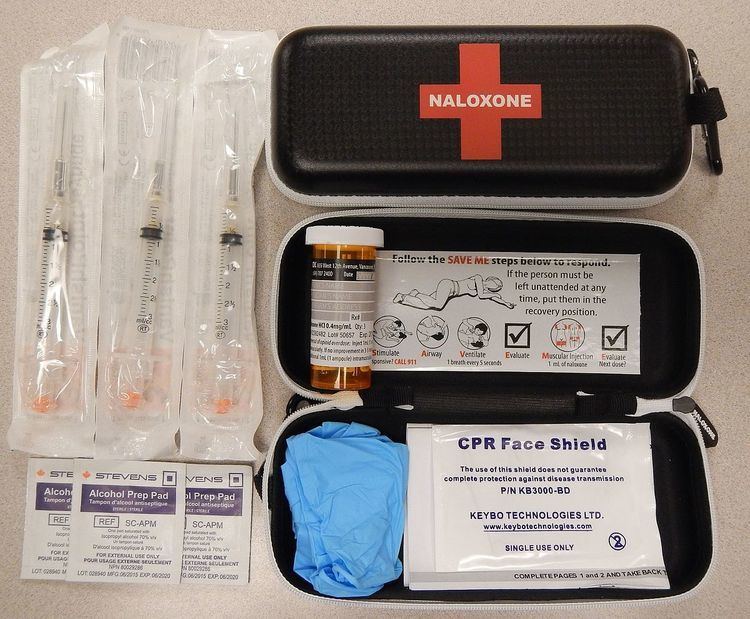Specialty emergency medicine ICD-9-CM 305.5, 965.0 | ICD-10 F11.0, T40.0-T40.2 eMedicine emerg/330 | |
 | ||
Opioid overdose is an acute condition due to excessive opioids. Examples of opioids are: morphine, heroin, tramadol, oxycodone, and methadone. It differs from opioid dependency. Although opioid overdose does not constitute a majority of the overdoses seen in the emergency department it is important to rule out in people given its potential for mortality and the ease of reversal. Dependence on prescription opioids can stem from treatment of chronic pain and in recent years is the cause of the increased number of opioid overdoses.
Contents
Initial treatment involves supporting the persons breathing and providing oxygen. Naloxone is then recommended among those who are not breathing.
Opioid use disorders resulted in 51,000 worldwide deaths in 2013 up from 18,000 deaths in 1990. Prescription opioid overdose was responsible for more deaths in the United States from 1999-2008 than heroin and cocaine overdose combined. Overdose deaths from heroin have almost increased 5 times from 2001 to 2013 in the United States. In 2015, in the United States about 20,100 deaths resulted from prescription opioids and 13,000 from heroin.
Signs and symptoms
Opioids, because of their effect on the part of the brain that regulates breathing, can during overdoses lead to the person not breathing (respiratory depression) and therefore result in death. Opiate overdose symptoms and signs can be referred to as the "opioid overdose triad": decreased level of consciousness, pinpoint pupils and respiratory depression. Other symptoms include seizures and muscle spasms. Sometimes a person experiencing an opiate overdose can lead to such a decreased level of consciousness that he or she won't even wake up to their name being called or being shaken by another person.
Prolonged hypoxia from respiratory depression can also lead to detrimental damage to the brain and spinal cord and can leave the person unable to walk or function normally, even if treatment with naloxone is given.
Alcohol also causes respiratory depression and therefore when taken with opioids can increase the risk of respiratory depression and death.
Co-ingestion
Opioid overdoses associated with a conjunction of benzodiazepines and/or alcohol use leads to a contraindicated condition. Other CNS depressants, or "downers", muscle relaxers, pain relievers, anti-convulsants, anxiolytics (anti-anxiety drugs), treatment drugs of a psychoactive or epileptic variety or any other such drug with its active function meant to calm or mitigate neuronal signaling (barbiturates, etc.) can additionally cause a worsened condition with less likelihood of recovery cumulative to each added drug. This includes drugs less immediately classed to a slowing of the metabolism such as with GABAergics like GHB or glutamatergic antagonists like PCP or ketamine.
Prevention
Although opioid overdose accounts for the leading cause of accidental death, it can be prevented in primary care settings. Clear protocols for staff at emergency departments and urgent care centers can reduce opioid prescriptions for individuals presenting in these settings who engage in "drug seeking" behaviors or who have a history of substance abuse. Providers should routinely screen patients using tools such as the CAGE-AID and the Drug Abuse Screening Test (DAST-10) to screen adults and the CRAFFT to screen adolescents aged 14–18 years. Other “drug seeking” behaviors and physical indications of drug use should be used as clues to perform formal screenings.
Individuals diagnosed with opioid dependence should be prescribed naloxone to prevent overdose and/or should be directed to one of the many intervention/treatment options available, such as needle exchange programs and treatment centers. Brief motivational interviewing can also be performed by the clinician during patient visits and has been shown to improve patient motivation to change their behavior. Despite these opportunities, the dissemination of prevention interventions in the US has been hampered by the lack of coordination and sluggish federal government response.
Prescription monitoring program allow physicians to view individuals' history of prescribed opioids and other controlled substances to prevent risky behaviors, such as doctor shopping and drug diversion. These programs are operational in 49 states and the District of Columbia, and have generally been found to decrease prescribing of opioids.
Regulative policies, such as Florida’s pill mill law, have also been found to decrease opioid prescribing and use, which are both correlated with opioid overdoses. Florida's pill mill law addressed pill mills, or rogue pain management clinics where prescription drugs are inappropriately prescribed and dispensed, and required these clinics to register with the state, have a physician-owner, created inspection requirements, and established prescribing and dispensing requirements and prohibitions for physicians at these clinics.
Treatment
Death can be prevented in opioid overdoses if patients receive basic life support and the administration of naloxone soon after opioid overdose is suspected. Naloxone is effective at reversing the cause, rather than just the symptoms, of an opioid overdose. A longer-acting variant is naltrexone. Naltrexone is primarily meant to treat opioid and alcohol dependence.
Programs to provide drug users and their caregivers with naloxone are recommended. In the United States its use is estimated to have prevented 10,000 opioid overdose deaths. Healthcare institution-based naloxone prescription programs have also helped reduce rates of opioid overdose in the US state of North Carolina, and have been replicated in the US military. Nevertheless, scale-up of healthcare-based opioid overdose interventions are limited by providers’ insufficient knowledge and negative attitudes towards prescribing take-home naloxone to prevent opioid overdose. Programs training police and fire personnel in opioid overdose response using naloxone have also shown promise.
